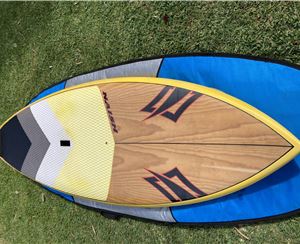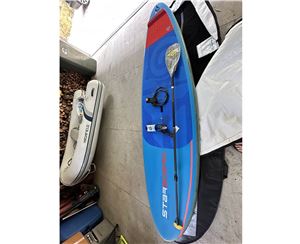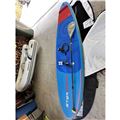Perfect your Stand Up Paddling Technique....
One of the great things about Stand Up Paddling and one of the things that sets it apart from other sports is the fact that it really is a fun way of getting around - you wouldn't fancy paddling a 6ft surfboard on a 5k downwinder for instance! Stand Up Paddle (SUP) is also a very efficient means of travelling - you can't get much simpler than a floating platform, a paddle and your power. And getting the 'power' element it crucial - technique is as important as hours in the gym, and you don't have to have rowed across the Pacific to become a great paddler. 
The basics:
Hand position - If you hold the paddle above your head then your elbows should be at a 90? angle. If they're too far either side of this then your paddling will be inefficient. Think about getting some tape and marking out where your bottom hand should be - at least till you get a feel for it.
Feet position - You may wonder what your feet have to do with paddling, but getting your foot position right is actually one of the key factors in an effective paddling technique. Think of your feet as the foundations for your arms and your paddle - weak foundations equal an unstable paddle technique. To get it right, your feet should be a shoulder width apart with one foot a couple of inches in front of the other to keep you stable front-to-back. If you're changing sides as you paddle then you'll need to decide whether or not to shuffle your feet as you switch sides with the paddle.
The technique:
You can break the paddle stroke down into distinct stages:
1. The Catch. This is when you get your paddle in the water and before you begin pulling it back. Have your arms fully extended, and then aim to place your paddle about a foot beyond where the paddle would enter the water if you kept it in a vertical position. Get your paddle blade deep into the water before you begin pulling back.
2. The Stroke. This is where the power comes from. A great way of ensuring good technique is to focus on pulling yourself past the paddle, rather than pulling the paddle past you... Keep your bottom arm almost straight and twist your shoulders for good positioning and to ensure that you really get 'over' the paddle and put maximum power into your stroke. You should aim for a good clean stroke in one consistent motion.
3. The Return. When your blade gets level with your feet then it's time to think about pulling it out of the water. By the time it's completely out it should be no more than two feet behind your body. Aim to lift the blade out quickly and at an angle - so that you're not lifting your arms up too high, but 'swinging' the blade away from you and out of the water. Once it's clear of the water, turn your blade through 90? - so that it's got minimal wind resistance - and bring it back up to the correct position for the start of The Catch.
Going in a straight line!
Some Stand Up Paddle boards will travel in a straight line better than others, and will require you to switch paddling side less often. Longer, narrower SUPs will naturally travel in a straighter line for example, as will boards with larger fins - some race boards can be paddled just on one side over long distances. A shorter, wider board (such as many SUP boards designed with surfing in mind), is designed to be more manoeuvrable and will thus require you to change paddle sides more often to keep going in the right direction.
A couple of tips...
Don't look at your board. The side of your board isn't straight, so if you follow the line of your board with your paddle then you'll naturally paddle in an arc and send the board away from 'straight'. Start with your paddle slightly out from your board (so that it's level with where it will be when it passes your feet - which is the widest part of the board), and pull it back in one clean, straight motion.
Tilt your board. If you dig in the rail (edge of your board) on the side of the board you are paddling on then you'll find that the board will deviate less. The key here is subtlety and, again, if you're on a longer or narrower board then you'll need to tilt your board less than if you're on a surfier SUP.
The final piece of advice is to just keep practicing... The more time you spend on the water the better your technique will become, and then have a read back over these key points and make sure you're getting them right. It may sound simple (you're just pulling a piece of plastic/carbon through the water right?!) but good technique takes a while to master and makes a world of difference. Good Stand Up Paddlling technique will see you getting to, and manoeuvring onto, waves much more effectively, or will see you streaking ahead of your mates next time you take on some flat water paddling or a 'friendly' race - so, get your technique right and make sure you're not getting the beers in next time round!














